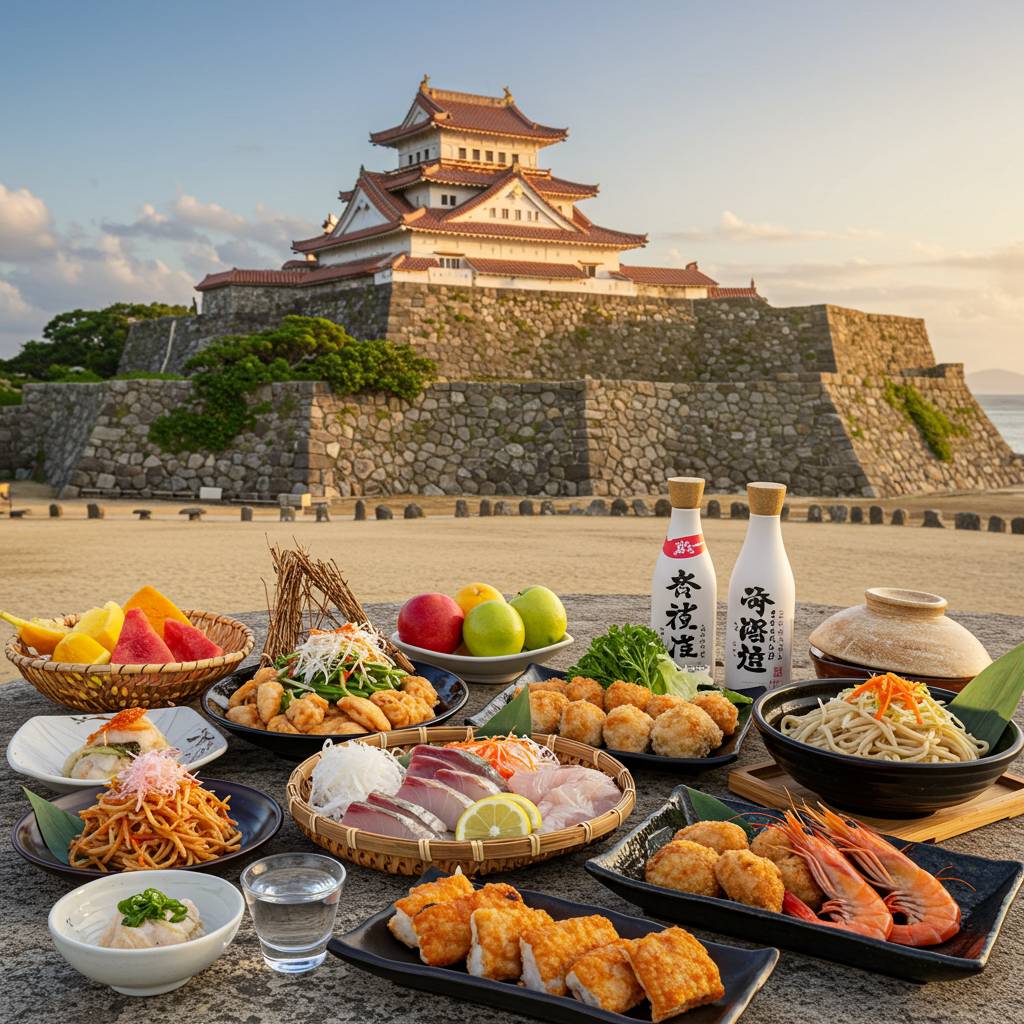# Culinary Traditions Near Okinawa’s World Heritage: What to Eat Where
Okinawa, Japan’s southernmost prefecture, is not only renowned for its stunning World Heritage sites but also for its distinctive culinary culture that reflects its unique history and geographical position. As you explore the cultural treasures of these islands, experiencing the local food traditions becomes an essential part of understanding Okinawa’s heritage.
## Shuri Castle Area: Royal Ryukyuan Cuisine
When visiting the magnificent Shuri Castle, a central component of the “Gusuku Sites and Related Properties of the Kingdom of Ryukyu” World Heritage designation, take time to sample the aristocratic cuisine that once served the royal court.
What to eat:
– **Rafute**: Tender pork belly simmered in awamori (Okinawan rice spirit), brown sugar, and soy sauce
– **Tundabun**: An elegant spread of small dishes served in traditional lacquerware
– **Kusuimun**: Royal court tea traditionally served with Chinsuko cookies
**Where to dine:** The restaurants near Shuri, such as Ryukyu Cuisine Mie or Ashibiuna, offer authentic royal Ryukyuan cuisine experiences with dishes prepared according to traditional recipes.
## Nakijin Castle Ruins: Northern Delicacies
The imposing stone walls of Nakijin Castle create a dramatic backdrop for exploring northern Okinawan cuisine, which features distinct local specialties.
What to eat:
– **Agu pork dishes**: Made from the native Okinawan black pig
– **Shikuwasa-flavored foods**: Local citrus fruit used in various dishes and drinks
– **Mozuku seaweed**: Often served as a vinegared dish
**Where to dine:** Restaurants like Café Garamanjaku near Nakijin offer farm-to-table experiences featuring locally grown ingredients.
## Zakimi Castle Site: Central Okinawa Specialties
While exploring the well-preserved walls of Zakimi Castle, discover the hearty traditional fare of central Okinawa.
What to eat:
– **Okinawa soba**: Wheat noodles in pork broth topped with slow-cooked pork
– **Tebichi**: Stewed pork feet, rich in collagen
– **Jimami tofu**: Peanut tofu, a unique Okinawan creation
**Where to dine:** Yanbaru-an near Yomitan Village serves exceptional Okinawa soba in a traditional setting.
## Sefa-utaki Sacred Site: Southern Island Flavors
This sacred space, once reserved for religious ceremonies conducted by the highest priestesses, is located in southern Okinawa where seafood specialties dominate the culinary landscape.
What to eat:
– **Inamuruchi**: Traditional fish soup with vegetables
– **Umi budo**: “Sea grapes” seaweed with a popping texture
– **Gurukun**: The prefectural fish of Okinawa, usually served deep-fried
**Where to dine:** Seafood restaurants in nearby Nanjo City, such as Umikaji Terrace’s restaurants, offer fresh catches with ocean views.
## Taketomi Island (Part of Iriomote-Ishigaki National Park): Yaeyama Cuisine
While exploring the preserved traditional village on Taketomi, part of the area now recognized for its natural significance, sample the distinctive cuisine of the Yaeyama Islands.
What to eat:
– **Yaeyama soba**: Different from Okinawa soba, made with flour noodles and a lighter broth
– **Tofuyo**: Fermented tofu, considered a delicacy
– **Hirayachi**: Savory pancakes with green onions
**Where to dine:** Restaurants like Yunangi on Taketomi Island offer authentic Yaeyama cuisine in traditional surroundings.
## Health Benefits of Okinawan Cuisine
Okinawa’s traditional diet is famous worldwide for contributing to the longevity of its residents. Key elements include:
– Low-calorie, nutrient-dense foods
– Abundance of vegetables and legumes
– Moderate fish consumption
– Limited meat and dairy
– Liberal use of herbs and spices with medicinal properties
## Practical Tips for Food Explorers
– The best food experiences are often found in small, family-run establishments
– Look for the “Okinawa Cuisine Promotion Association” certification mark for authentic experiences
– Many traditional dishes can be sampled at the Makishi Public Market in Naha
– Consider a cooking class to learn the techniques behind these heritage recipes
– Pair meals with local beverages like awamori, sanpin (jasmine) tea, or craft beer from Okinawa’s growing brewery scene
Exploring Okinawa’s World Heritage sites offers a journey through time, and complementing these experiences with local cuisine adds another dimension to understanding this unique culture. The flavors of Okinawa tell stories of its past—from Chinese influence and royal court traditions to the pragmatic cuisine of farming and fishing communities—creating a culinary heritage as rich and varied as its celebrated historical sites.
沖縄のレンタカー予約は「レンタカー広場」
レンタカー広場で最高の旅の思い出を!
レンタカーの予約はこちらから↓
・沖縄の格安レンタカーが最安値「1,500円~」予約・比較はレンタカー広場がおすすめ
https://rentacar-hiroba.com/

